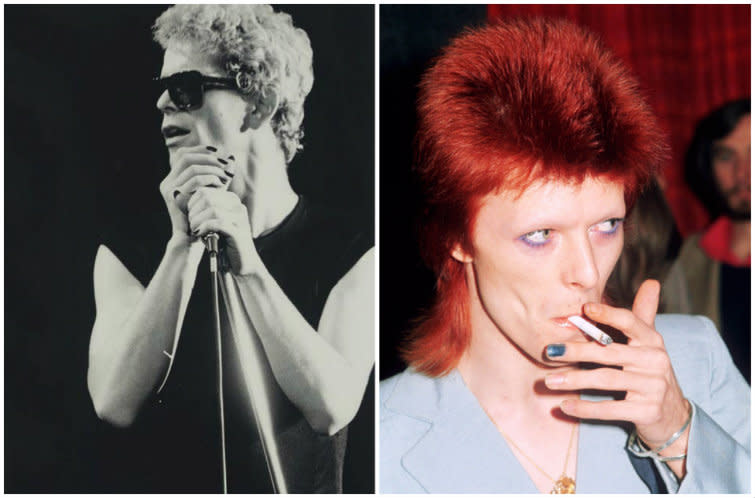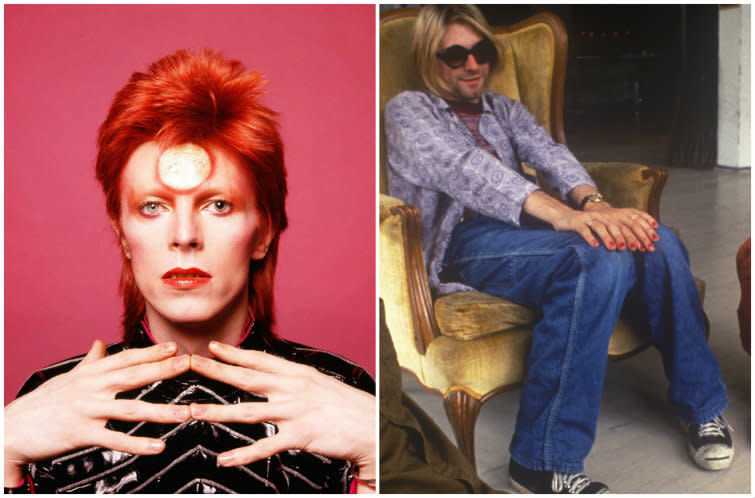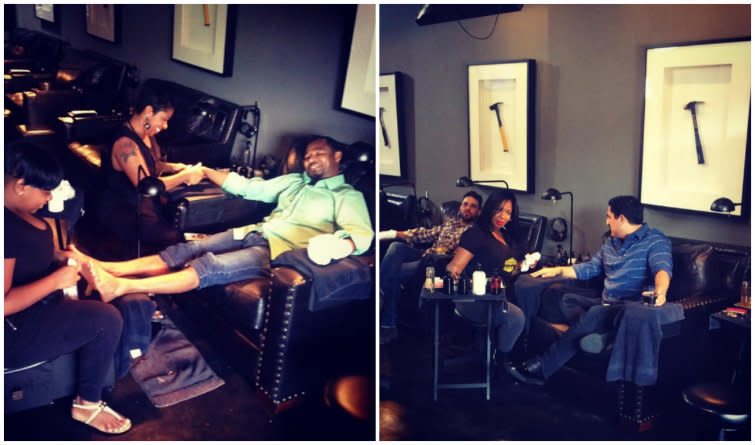Nail Polish for Men Is Finally "Normal" — Just Like It Used to Be 5,000 Years Ago
When 17-year-old Jaden Smith posed for Vogue Korea in January, the internet (ourselves included) went berserk.
"He's our gender-fluid bae!" we screamed. To Teen Vogue, Smith was "smashing gender norms in a miniskirt." To the Huffington Post, he was a "gender-fluid dream come true." According to Entertainment Tonight, he looked "stunning shirtless in a skirt with a flower in his hair."
What made headlines was the skirt — not the blue nail polish on his fingers. Sure, it was far less noticeable, only apparent if you take a closer look; still, the style statement wasn't treated with nearly the importance as the skirt. A 17-year-old guy wearing nail polish, it would seem, is not really a big deal.
Smith is hardly alone. Plenty of other men as of late have been seen wearing nail polish, including Johnny Depp, Taye Diggs, Seal, Jared Leto, Brad Pitt, Zac Efron, Elden Henson of The Hunger Games, Darren Criss, Harry Styles and more. Early in 2015, Elle even asked if 'MAN'icures were going to be the next "thing."
But really, it's not a new thing at all. In fact, nail polish for dudes used to be the norm.

History is actually repeating itself: Men have been wearing nail polish since 3,200 B.C. Following an excavation of royal tombs at Ur of the Chaldees in southern Babylonia, it was reportedly discovered that most men during that era wore nail polish, with different colors signifying different classes. Made primarily with kohl, the darker the color, the higher the class of the man, from warriors to leaders. Lighter colors were reserved for lower class men. In fact, prior to battle, warriors would take hours to primp and paint their nails just so.
In 3,000 B.C., it's said that in China, nail varnish — which was made from a mixture of egg whites, beeswax and gelatin — was reserved for people in the higher classes regardless of gender. In Egypt, people of all classes were encouraged to paint their nails, again with color denoting status. Members of the upper classes, including icons like Nefertiti and Cleopatra, tended to wear red made from plant extracts.
There's little documentation of how nail polish turned into a specifically feminine expression as the years ticked on. What we do know is that by 1800s France, it was primarily women who would paint their nails to signify their own cleanliness. By the 1930s, companies like Revlon were marketing red and pink polishes directly to female customers.
The counterculture brought it back: Flash forward to the rise of counterculture in the United States and artists such as Iggy Pop, Kurt Cobain, Lou Reed and David Bowie, all of whom were notable proponents of painting varnish on their nails.
All the men above were rock stars, rebelling against the gender norms their elders obeyed. In Bowie's case, critics just didn't know what to do with his androgynous look, since rockers of the past had been forced into being extremely hyper-masculine, sexual figures. The same happened with Reed, who, when he painted his nails with Bowie, was described as "freaky."


After Cobain painted his in the '90s, it was frequently called out in profiles by publications such as Spin and Esquire, which noted, "His red nail varnish is badly chipped. His dirty blonde hair is damp and frames his unexpectedly beautiful face."
The other counterculture site of men's nail polish? Goth culture, also familiar to '90s kids.
"I wear black lipstick and black nail vanish and I also wear black eyeliner," wrote one British 12-year-old, Josh, in a BBC feature on Goth kids in 2004.
The shift back to normalcy: But something has shifted in the past few years, as evidenced not only by stars like Smith, but also the emergence of nail polish brands catering toward men. Blame it on the rise of the "metrosexual" and of male grooming, or the growing acceptance of gender fluidity.
Take Manglaze, for instance, which is not in fact glaze made from melted down man to go on top of your cinnamon roll, but a purchasable line of nail polish for men that launched in 2007. A few years later in 2013, a salon specifically for men opened in Los Angeles. Called Hammer & Nails, the salon specializes in nail care and manicures for men in an industrial setting, proving that painting and caring for your nails isn't just for male celebrities, but for any man out there.

One of the men who has embraced that level of nail care is makeup artist William Bob Scott, 24, who sees painting his nails more like an accessory than anything. "It's visual weight," Scott told Mic. "It's something dark where my hands are and I have big hands, and it's just nice visually."
In an essay on Medium titled "Why I Wear Nail Polish," author Jonathon Reed wrote he wears red nail polish not to start a revolution but because it's a positive self-identifier. "I paint it on when I'm feeling sad or lost as a visual reminder of a time that I was happy and fulfilled," he wrote. "It's a piece of self-identity, and it gets me through hard days."
They're not trying to signal a rebellion or make much of a statement. They're wearing it for a variety of personal reasons — mostly because they just like it.
A stigma remains, but is slowly fading: Scott said a lot of the stigma has to do with the idea that men aren't supposed to care too much about their appearances.
"I think it's definitely been taboo for guys because it's primping and polishing and a feminine thing most macho guys won't do," he said. "It's so small and such an arbitrary thing but for most guys, they can't even take the time to brush their hair."
In his essay, Reed similarly felt people's issue with his nails had to do with gender expectations. "Effeminate boys are viewed as having given up power, because masculine concepts of physical and emotional toughness have largely remained unquestioned as a boyhood ideal," he wrote.
That's definitely what Allure magazine found issue with in 2012, when it swiftly shot down the idea that men in nail polish were in any way appealing.
"It's all way over the top for my taste," Renee Trilivas wrote. "Women are attracted to guys who take care of themselves, but using a beauty product like this catapults a man into high-maintenance territory. If I have to wait for his polish to dry before we go to dinner, I'm out of there."
And yet the oh so progressive millennial generation is helping loosen that stigma's grip. Scott said he's seen a difference in how people of different ages react to his nails.
"The younger generation is now at the forefront of the whole fluidity thing," Scott said. "So it's perfectly normal for them because they're growing up eye to eye with people who are experimenting. For teens these days, it's like 'Who is this really affecting?'"
That's the particular group of young people Smith is finding himself in today. Among his peers are Amandla Stenberg and Rowan Blanchard, who have been open about experimenting with their own gender identities, expressions and sexualities. Given his new track record of openly embracing fashions typically associated with women, Smith painting his nails wasn't going against his own grain. If anything, he just showed his throngs of fans, who certainly aren't all famous, that men wearing nail polish isn't really that taboo. After all, it didn't used to be.